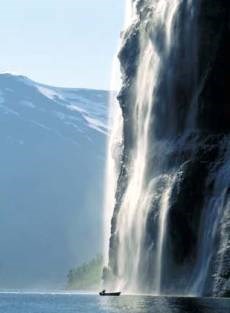Geirangerfjord and Nærøyfjord included on UNESCO’s World Heritage List
Historical archive
Published under: Bondevik's 2nd Government
Publisher: Ministry of the Environment
Press release | Date: 14/07/2005 | Last updated: 24/10/2006
UNESCO’s World Heritage Committee has today included Geirangerfjord and Nærøyfjord on the prestigious World Heritage List, which comprises the world’s most important cultural and natural heritage sites. (14.07.05)
Press release
Date: 14.07.05
Geirangerfjord and Nærøyfjord included on UNESCO’s World Heritage List
UNESCO’s World Heritage Committee has today included Geirangerfjord and Nærøyfjord on the prestigious World Heritage List, which comprises the world’s most important cultural and natural heritage sites.
 - This marks the
inclusion of Norway’s first natural heritage areas on the list.
Norway thus takes on a major responsibility to preserve these areas
for posterity, says Environment Minister Knut Arild Hareide.
- This marks the
inclusion of Norway’s first natural heritage areas on the list.
Norway thus takes on a major responsibility to preserve these areas
for posterity, says Environment Minister Knut Arild Hareide.
During UNESCO’s 29th World Heritage
Committee meeting in Durban in South Africa it was decided today to
include Geirangerfjord and Nærøyfjord, and their surroundings, on
the World Heritage List.
Brudesløret in Geiranger. Photo: Arne
Aasheim
It is because of the pre-eminent geological qualities and the uniquely beautiful natural landscape that Norway has succeeded in getting its first natural heritage site included on the prestigious list.
- The decision is a major acknowledgement of all those who for generations have seen the value of preserving one of the world’s absolutely most impressive landscapes for posterity. The status on the World Heritage List is the highest international quality stamp a landscape can achieve, and only sites which can document cultural or natural qualities of the highest order, combined with good management, get included on the list, says Environment Minister Knut Arild Hareide.
As a basis for the decision the World Heritage Committee cites the fact that Nærøyfjord and Geirangerfjord are considered to be among the most beautiful fjord landscapes on the planet.
Their unique natural beauty stems from the narrow valleys with steep crystalline mountainsides which stretch from 500 meters below the surface of the water to 1400 meters high above the Norwegian Sea. Innumerable waterfalls cascade down the almost vertically steep mountainsides and a large number of free-running rivers flow down from jagged mountains, glaciers and glacier lakes, through deciduous and coniferous forests, and into the fjords. A great diversity of other natural phenomena, on land and in water, with inter alia underwater moraines and marine mammals, strengthen the experience of nature. Remains of older - and for the most part abandoned – low-lying and alpine farms add a cultural dimension to the dramatic natural landscape which complements and heightens the overall value of the area.
The World Heritage area is part of six municipalities and three counties: Møre and Romsdal, Hordaland and Sogn and Fjordane. Geiranger Fjord stretches across Norddal and Strand municpalities, while Nærøyfjord includes Voss, Aurland, Vik and Lærdal municipalities.
The Directorate for Nature Management was entrusted by the Minstry of the Environment with leading the task of compiling the application which was transmitted to UNESCO in January 2004. UNESCO later commented that the technical quality of the very thorough Norwegian application was among the best they had seen in the 30 year history of the Convention.
Norway had previously had five sites included on the World Heritage List. Bryggen in Bergen, Urnes stave church, the mining town Røros, the rock carvings in Alta and Vegaøyan. The West-Norwegian fjord landscape is the first area which has been included after having met the natural heritage criteria of the Convention.
- Natural heirtage is under-represented on the World Heritage List and Norway through inclusion of the first Norwegian natural heritage area on the list contributes to improving the balance between natural and cultural heritage sites in line with UNESCO’s global strategy, says Hareide.
Contact persons:
Einar Holtane (Ministry of the Environment): mob:+47
41650194
Olav Nord-Varhaug (Directorate for Nature Management) mob:
+47 90023242